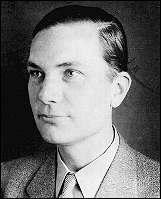 |
 |
 |
 |
 |
 |
|
NAZI PERSECUTION OF HOMOSEXUALS
|
|
After taking power in 1933, the Nazis persecuted homosexuals as part of their so-called moral crusade to racially and culturally purify Germany. This persecution ranged from dissolution of homosexual organizations to internment of thousands of individuals in concentration camps. Gay men, in particular, were subject to harassment, arrest, incarceration, and even castration. In Nazi eyes, gay men were weak and unfit to be soldiers, as well as unlikely to have children and thereby contribute to the racial struggle for Aryan dominance. Follow the links on this special focus page to learn more about the Nazi campaign against homosexuals in Germany.
|
|
 |
|
|
Friedrich-Paul von Groszheim
Born Luebeck, Germany April 27, 1906
|
Friedrich-Paul was born in the old trading city of Luebeck in northern Germany. He was 11 when his father was killed in World War I. After his mother died, he and his sister Ina were raised by two elderly aunts. After graduating from school, Friedrich-Paul trained to be a merchant.
1933-39: In January 1937 the SS arrested 230 men in Luebeck under the Nazi-revised criminal code's paragraph 175, which outlawed homosexuality, and I was imprisoned for 10 months. The Nazis had been using paragraph 175 as grounds for making mass arrests of homosexuals. In 1938 I was re-arrested, humiliated, and tortured. The Nazis finally released me, but only on the condition that I agree to be castrated. I submitted to the operation.
1940-44: Because of the nature of my operation, I was rejected as "physically unfit" when I came up for military service in 1940. In 1943 I was arrested again, this time for being a monarchist, a supporter of the former Kaiser Wilhelm II. The Nazis imprisoned me as a political prisoner in an annex of the Neuengamme concentration camp at Luebeck.
After the war, Friedrich-Paul settled in Hamburg.
More Personal Stories
|
|
|
|
|
|
 Did You Know... Did You Know...
- Under Paragraph 175 of the criminal code, male homosexuality was illegal in Germany. The Nazis arrested an estimated 100,000 homosexual men, 50,000 of whom were imprisoned.
- During the Nazi regime, the police had the power to jail indefinitely--without trial--anyone they chose, including those deemed dangerous to Germany's moral fiber.
- Between 5,000 and 15,000 gay men were interned in concentration camps in Nazi Germany. These prisoners were marked by pink triangle badges and, according to many survivor accounts, were among the most abused groups in the camps.
- Nazis interested in finding a "cure" for homosexuality conducted medical experiments on some gay concentration camp inmates. These experiments caused illness, mutilation, and even death, and yielded no scientific knowledge.
|
|

